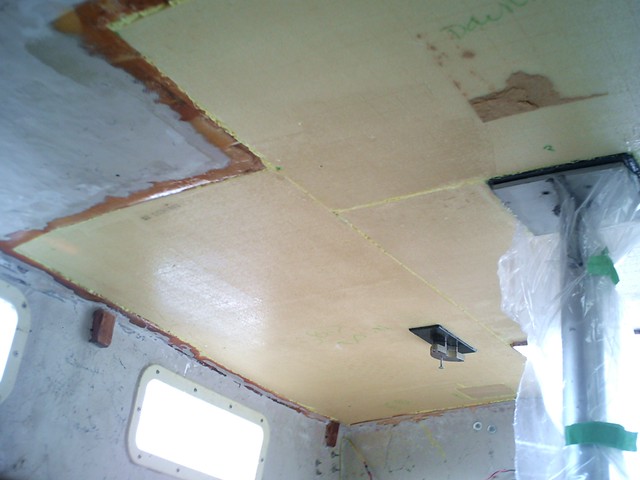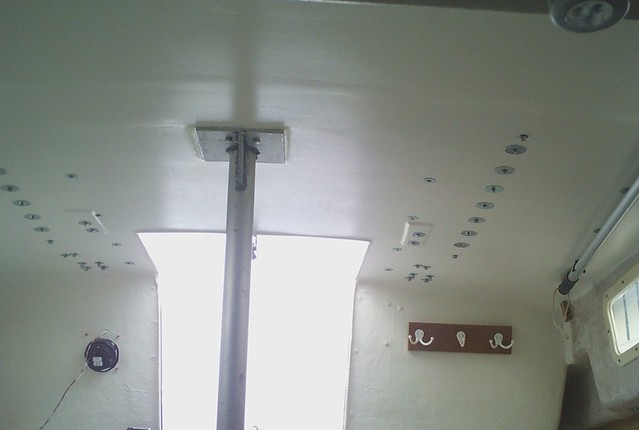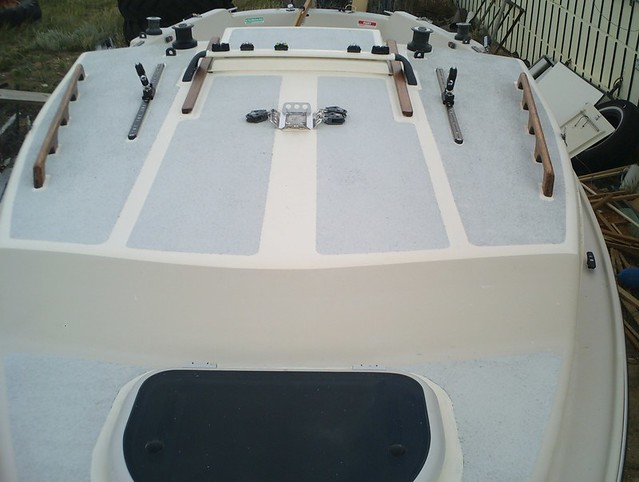Welcome, Bill. Recoring the deck is an inevitable SJ21 project; it's not bad at all, once you get in the swing of it. Have you determined how much core you will need to replace, and where the soggy bits are? That's always the first step.
We recored from a foot before the mast step to the bulkhead on our Mark 1. We worked from below, which is somewhat of a pain because you are fighting gravity; OTOH, the inner skin is dangerously thin as a reference surface, and keeping the original outer skin intact saves a lot of tedious cosmetic blending. Possibly the best solution is flipping the boat (only half kidding.

)
We chose CoreCell foam; it's not quite as strong as balsa in pure compression, but its flexural properties are better. And compression isn't so important because we put solid phenolic cores under the winches, mast step, and the controls bridge that spans our hatchway. Plywood is the worst core material: it wicks and rots like balsa, but without any of foam's or balsa's weight advantage.
You can buy balsa in 2x4' (and possibly 2x2') sheets, with blocks glued to a fabric scrim. This is easier then bedding individual blocks, but you have to work fast. Jamestown Distributors and Defender both sell it. Core on our boat was 3/8"t. I think the Contour Core balsa (on the scrim) comes pre-sealed and ready to use; raw balsa blocks may need substantial 'buttering' before you bed them, lest they drink all the bedding resin and leave a dry joint. (Foam also needs buttering.) Definitely use marine epoxy, rather than polyester or vinylester resin. Cab-O-Sil is a handy, inexpensive thickener.

Once the solid cores and the foam were glued in, we applied three layers of fabric plus a fairing coat, sanded, and painted the interior. I could have spent more time smoothing it out and hiding the weave, but frankly ... it's a hell of a lot neater than the factory finish! 'Better than Clark, less good than Hinkley' is our guiding principle.

Finally, do yourself and posterity a favor & isolate all thru-deck fasteners from whatever core material you choose by drilling, overboring, filling, and re-drilling the penetrations. It's tedious and there's all kinds of arguments over the best way to do it, but it really is worth the time. Even the best bedding compounds can fail; having a solid epoxy 'bushing' around every thru-deck fastener means it's no big deal if things start to seep.
My approach (not the only one) is to drill down from above with a 3/16" or 1/4" bit, according to the bolt size. Then I cautiously drill up from below with a 1/2" or 5/8" bit, deliberately ground to a shallow angle and not overly sharp. This prevents self-feeding. You may want to arrange a stop collar; I just did it by feel (but I spend all day with a drill in my hand.) You now have a small hole in the top skin and a larger hole thru the bottom skin & core, with all core material removed. Tape over the lower holes and inject epoxy from above -- neat first, then as thick as you can squirt it. Vibrate the deck around the holes, then go back around & top off any that settle. When it cures, redrill with the correct diameter drill (some people will drill a funnel-shaped hole) and bed your hardware.
Sounds awful, but the whole thing took under a week and cost a couple hundred bux. BTW, since we had the hardware off anyhow, we took the opportunity to upgrade winches, jib cars, put a plate under the mast, and we painted the decks with KiwiGrip non-skid. That rather added to the cost.

And of course, it helps to have sailed the boat for a few years, so you know what changes you want.

You can sail with a wet core for awhile, too. Our was wet for probably a decade under the PO, and we sailed it wet for a couple more years.
Welcome again, & keep us apprised of your progress!
Bob McGovern
Laramie, WY


